Click on images to enlarge

infestation (Photo: Sheldon Navie)

habit (Photo: Sheldon Navie)
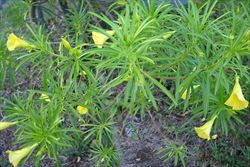
flowers and leaves of yellow-flowered form (Photo: Sheldon Navie)
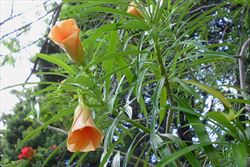
flowers and leaves of orange-flowered form (Photo: Sheldon Navie)
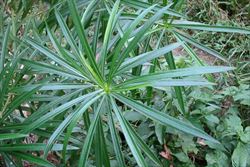
elongated leaves (Photo: Sheldon Navie)

close-up of leaves (Photo: Sheldon Navie)
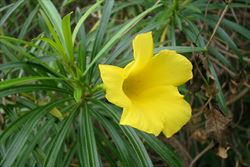
close-up of tubular yellow flower (Photo: Sheldon Navie)
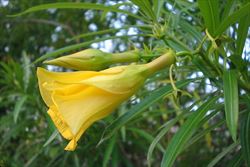
close-up of flower and flower bud from side-on (Photo: Sheldon Navie)

immature fruit (Photo: Sheldon Navie)
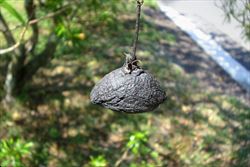
mature fruit (Photo: Sheldon Navie)

seedling (Photo: Sheldon Navie)

infestation along Ithaca Creek in Brisbane (Photo: Sheldon Navie)
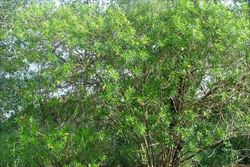
habit (Photo: Sheldon Navie)

close-up of orange flower (Photo: Sheldon Navie)

close-up of young and immature fruit (Photo: Sheldon Navie)
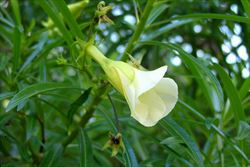
Cascabela thevetia 'Alba' (Photo: Sheldon Navie)
Scientific Name
Cascabela thevetia (L.) Lippold
Synonyms
Cascabela peruviana (Pers.) Raf.Cerbera peruviana Pers.Cerbera thevetia L.Thevetia nerifolia Juss. ex Steud.Thevetia peruviana (Pers.) K. Schum.Thevetia thevetia (L.) Millsp.
Family
Apocynaceae
Common Names
be still tree, be-still tree, bestill tree, Captain Cook tree, Cook tree, dicky plant, foreigner's tree, lucky nut, luckynut, Mexican oleander, still tree, yellow oleander
Origin
Native to tropical America (i.e. possibly Peru, Mexico and the Caribbean).
Cultivation
This species is still widely cultivated in Australia, and is most commonly in sub-tropical and tropical regions. In addition to the relatively common yellow- and orange-flowered forms of this species, there is also a relatively rare white-flowered cultivar known as Cascabela thevetia 'Alba'.
Naturalised Distribution
Naturalised populations are distributed mainly in the coastal areas of eastern Australia. It is most common in coastal southern and central Queensland. Scattered populations are also present in the coastal parts of northern Queensland, the Northern Territory and northern Western Australia (e.g. at Koolan Island). Also recorded in New South Wales (particularly near Grafton) and in non-coastal parts of Queensland and Western Australia.
Naturalised overseas in south-eastern USA (i.e. Florida), on Timor and on several Pacific Islands (i.e. Cook Islands, Fiji, French Polynesia, Niue, Midway Atoll and Hawaii).
Habitat
A weed of waterways, roadsides, waste areas, disturbed sites, old gardens, open woodlands, pastures, coastal environs and occasionally plantation crops in tropical and sub-tropical regions.
Habit
An upright (i.e. erect) and much-branched shrub usually growing 2.5-3.5 m tall, but occasionally a small tree reaching up to 10 m in height.
Distinguishing Features
- an upright and spreading shrub or small tree with leaves that are spirally arranged along the stems.
- its long and narrow leaves have glossy green upper surfaces and paler undersides.
- its stems and leaves contain a milky sap.
- its bright yellow, or occasionally pale orange, tubular flowers (5-7 cm long) have five petals that are twisted when in bud.
- its fruit is large and slightly fleshy with a hard centre (25-55 mm across) and turns black as it matures.
Stems and Leaves
The stems and leaves contain a poisonous milky sap (i.e. latex). Older stems are pale brown or greyish in colour and relatively smooth, while younger stems are glossy green in colour and hairless (i.e. glabrous).
The leaves (5.5-15 cm long and 4-15 mm wide) are spirally arranged along the stems and often they are rather densely clustered near the tips of the stems. They are long and narrow (i.e. linear or lanceolate) in shape, with obscure leaf stalks (i.e. petioles) 1-4 mm long, and prominent central veins (i.e. midribs). These leaves are hairless (i.e. glabrous) with glossy green upper surfaces and paler, duller, undersides. The leaf tips are pointed or somewhat rounded (i.e. acute or sub-obtuse apices) and the leaf margins are curved downwards (i.e. recurved).
Flowers and Fruit
The bright yellow, or occasionally pale orange, flowers are arranged in several-flowered clusters near the tips of the branches. These flowers are tubular in shape (5-7 cm long) with five petal lobes (35-40 mm long) that are twisted and overlapping when in bud. The flowers also have five narrow green sepals (5-13 mm long) that are fused near the base (i.e. the calyx is deeply five-lobed) and are borne on stalks (i.e. pedicels) 15-37 mm long. Flowering occurs throughout the year, but mostly during summer and autumn.
The relatively large fruit is slightly fleshy with a hard centre (i.e. it is a drupe). It is somewhat broader than it is long (25-55 mm across) and is often somewhat triangular in outline (i.e. obtriangular) when mature. These fruit are green and glossy when young, but turn black and become slightly shrivelled as they ripen. Each fruit contains 2-4 large, flattened, seeds (about 35 mm long and 15 mm wide) in its woody centre.
Reproduction and Dispersal
This plant reproduces only by seeds. These are commonly spread in dumped garden waste.
Environmental Impact
This species and is regarded an environmental weed in south-eastern Queensland, where it is on the list of the top 200 invasive naturalised plants, and as a priority weed in far northern Queensland. It is also seen as a potential sleeper weed in other states. It has already become established in conservation areas in south-eastern Queensland (e.g. St. Helena Island National Park near Brisbane), as well as in bushland and riparian areas, and has also been reported to invade coastal vegetation in northern Queensland (e.g. at Balgal Beach near Townsville).
Other Impacts
All parts of this plant are very poisonous, especially the oily seeds.
Legislation
This species is declared under legislation in the following states and territories:
- Queensland: Class 3 - this species is primarily an environmental weed and a pest control notice may be issued for land that is, or is adjacent to, an environmentally significant area (throughout the entire state). It is also illegal to sell a declared plant or its seed in this state.
- Western Australia: Unassessed - this species is declared in other states or territories and is prohibited until assessed via a weed risk assessment (throughout the entire state).
Similar Species
Yellow oleander (Cascabela thevetia) may occasionally be confused with yellow bells (Tecoma stans) and oleander (Nerium oleander). These species may be distinguished by the following differences:
- yellow oleander (Cascabela thevetia) has simple leaves that are long and narrow, with entire margins and obscure stalks (i.e. petioles). Its tubular flowers are bright yellow or occasionally pale orange. The broad fleshy fruit (25-55 mm across) are somewhat rounded and turn black when mature.
- yellow bells (Tecoma stans) has compound (i.e. pinnate) leaves with several toothed (i.e. serrated) leaflets and long slender stalks (i.e. petioles). Its tubular flowers are bright yellow with some small reddish-coloured markings in the throat. The long and narrow capsules (10-30 cm long) are light brown in colour when mature and split open to release numerous papery seeds.
- oleander (Nerium oleander) has simple leaves that are long and relatively narrow, with entire margins and short stalks (i.e. petioles). Its tubular flowers are usually pink, reddish-purple or white (occasionally salmon or yellow). The cylindrical fruit (12-25 cm long) are very elongated and split open when mature to release numerous very hairy seeds.
This fact sheet has been updated thanks to the sponsorship of Sunshine Coast Council.

